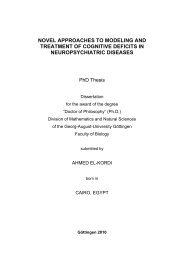Cortical and subcortical mechanisms in persistent stuttering ...
Cortical and subcortical mechanisms in persistent stuttering ...
Cortical and subcortical mechanisms in persistent stuttering ...
You also want an ePaper? Increase the reach of your titles
YUMPU automatically turns print PDFs into web optimized ePapers that Google loves.
are used for motor preparation (Bengtsson et al., 2009). Therefore, the left PMd might serve<br />
as an <strong>in</strong>terface between sensory prediction <strong>and</strong> temporally precise motor <strong>in</strong>itiation (Kurata et<br />
al., 2000; Ramnani <strong>and</strong> Pass<strong>in</strong>gham, 2001). Consequently, an rTMS <strong>in</strong>duced dysfunction of<br />
the left PMd might alter the functional connectivity of the cerebello-thalamo-cortical loop<br />
which results <strong>in</strong> less precise timed motor behavior.<br />
This f<strong>in</strong>d<strong>in</strong>g is consistent with a hemispheric dom<strong>in</strong>ance of the left PMd <strong>in</strong> AWNS reported<br />
by Koch et al. (Koch et al., 2006) dur<strong>in</strong>g a response selection task <strong>and</strong> by Pollok et al. (2008)<br />
for movement tim<strong>in</strong>g dur<strong>in</strong>g auditory paced f<strong>in</strong>ger tapp<strong>in</strong>g. Nevertheless, this hypotheses is<br />
not unchallenged s<strong>in</strong>ce <strong>in</strong> a response selection experiment, O`Shea et al. (O'Shea et al., 2007)<br />
did not f<strong>in</strong>d evidence for such a hemispheric dom<strong>in</strong>ance. Rather, they demonstrated that<br />
changes <strong>in</strong> functional connectivity occur <strong>in</strong> the pathway l<strong>in</strong>k<strong>in</strong>g<br />
PMd <strong>and</strong> contralateral M1.<br />
Right-shifted control of movement tim<strong>in</strong>g <strong>in</strong> AWS<br />
In contrast to AWNS, right rTMS prolonged left h<strong>and</strong> asynchrony <strong>in</strong> AWS, whereas left<br />
rTMS was <strong>in</strong>effective. Previous behavioral (Curry <strong>and</strong> Gregory, 1969; Sommers et al., 1975),<br />
physiological (Biermann-Ruben et al., 2005; Moore <strong>and</strong> Lang, 1977) <strong>and</strong> neuroimag<strong>in</strong>g<br />
studies (Braun et al., 1997; De Nil <strong>and</strong> Brutten, 1991; Ingham et al., 2004; Preibisch et al.,<br />
2003) provide evidence for a cerebral imbalance <strong>in</strong> AWS with an <strong>in</strong>creased <strong>in</strong>volvement of<br />
the right hemisphere dur<strong>in</strong>g speech production. Our results are <strong>in</strong> l<strong>in</strong>e with neural imag<strong>in</strong>g<br />
studies suggest<strong>in</strong>g an aberrant role of the left PMd (Lu et al., 2010) <strong>and</strong> an additional<br />
<strong>in</strong>volvement of the right PMd dur<strong>in</strong>g speech (Braun et al., 1997; Fox et al., 1996; Ingham,<br />
2001) <strong>and</strong> even non-speech tasks <strong>in</strong> AWS (Chang et al., 2009; Morgan et al., 2008).<br />
Accord<strong>in</strong>gly, us<strong>in</strong>g functional magnetic resonance imag<strong>in</strong>g right h<strong>and</strong> f<strong>in</strong>ger tapp<strong>in</strong>g has been<br />
shown to be associated with bilateral pre- <strong>and</strong> post-central activation with <strong>in</strong>creased activation<br />
of the right hemisphere <strong>in</strong> AWS as compared to AWNS (Morgan et al., 2008). Thus, less<br />
activation of the left premotor area <strong>and</strong> stronger activation of the right premotor area are not<br />
specific for speech <strong>in</strong> AWS, an <strong>in</strong>terpretation corroborated by the<br />
present f<strong>in</strong>d<strong>in</strong>gs.<br />
No effects on right h<strong>and</strong> performance <strong>in</strong> both groups<br />
Previous studies documented contradictory data result<strong>in</strong>g from rTMS over the left PMd on<br />
right h<strong>and</strong> movement tim<strong>in</strong>g <strong>in</strong> non-stutter<strong>in</strong>g adults (Del Olmo et al., 2007; Doumas et al.,<br />
2005; Pollok et al., 2008). The present study showed an effect of left PMd rTMS on the<br />
subdom<strong>in</strong>ant left h<strong>and</strong> only. With<strong>in</strong> our sample of fluently speak<strong>in</strong>g participants right<br />
h<strong>and</strong>edness was less strongly developed (group average 76; median 70). Thus, one might<br />
speculate that the rTMS effect occurs <strong>in</strong> strongly developed right h<strong>and</strong>edness only (i.e.,<br />
42



